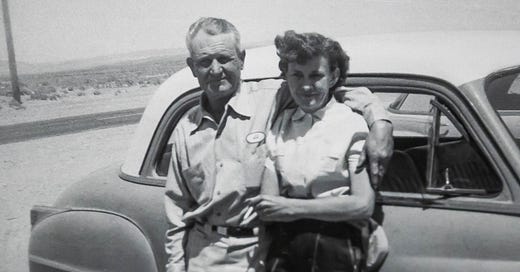The 20 Rs of Resilience: Powerful Strategies to Master Disaster Preparedness
And a Revisiting of a Depression Era Mindset
Reflecting on my earlier years, I realize the perspective I grew up with diverges significantly from the norms of abundance that seduces modern sensibilities. I descend from a lineage of scarcity, a legacy of the Great Depression that my grandmother and grandfather survived. Their experiences, etched into our family's DNA, fostered a deep reverence for the material we had—each item imbued with value, each possession a treasure not easily relinquished. My mother, steeped in this ethos, passed it down like a sacred rite. There was a profound resilience embedded within this approach, a product of necessity defined by my grandparents’ generation.
Don’t miss the 20 Rs of Resilience at the end of this post.
In the contemporary landscape, the notion of scarcity seldom crosses our minds. We've grown accustomed to a world where our next need seems just a click away, rendering the cautious stewardship of resources seemingly obsolete. Yet, the reality we face is one riddled with unpredictability—natural disasters, sudden emergencies, resource depletion, environmental degradation, economic instability, and fragile supply chains threaten our comfortable existence. Our brains, not naturally inclined to anticipate the long-term, often default to a misguided trust in external solutions, like government intervention, to bail us out. But this complacency stands on shaky ground. The truth is stark and demands our attention: it's time to revive the wisdom of the Depression-era mindset. We must engage in open, candid discussions about our vulnerabilities and take proactive steps towards bolstering the resilience of our homes and communities against the unpredictable challenges that lie ahead.
Know How
In the arid expanses of California's desert, my grandparents nurtured my mother amidst the agricultural fields they called home. The challenge of securing water in such a stark landscape was daunting. Yet, my grandfather, a master well witcher, wielded his unique skill with a divining rod, crafted from specific trees, to unearth fresh water where others saw none—despite the skepticism faced due to the proximity to alfalfa farms, which thrived on alkaline water. Against all odds, he discovered a fresh water source, building their home beside the well he fashioned. This profound knowledge of sourcing water and establishing a homestead embodies a wisdom and self-sufficiency that seems all too rare in today's world.
Waste Not, Want Not
This maxim, often heard in my youth, eluded my full comprehension then. We lived in abundance, seemingly exempt from the consequences of waste. However, as I've matured, the profound significance of this principle has become unmistakably clear. Today, the opportunities to embody this adage are abundant, extending far beyond the symbolic gesture of shorter showers, which scarcely impacts global water reserves. It's about embracing a resilient lifestyle, one that could very well be pivotal for our survival. This ethos promotes a conscious awareness of our consumption and its impact on the planet, advocating for a thoughtful and sustainable interaction with the resources we depend on.
What does it truly mean to be resilient?
While possessing supplies and skills is beneficial, it's merely the tip of the iceberg. True resilience is forged through the development of a mindset, the adoption of a lifestyle, and the nurturing of a community capable of weathering any storm. Enter the "20 Rs of Resilience," a guide aimed at equipping individuals and communities with the comprehensive understanding, abilities, and tactics essential for navigating an unpredictable world.
At the heart of the Collapse Curriculum, our goal is to forge a comprehensive course of study focused on our reactions to the faltering structures of our current system. The 20 essential tenets of resilience we've identified serve as the cornerstone of this educational endeavor, offering a structured framework. In future sections, we'll delve into each principle with increased specificity, laying the groundwork for a deeper understanding and application.
Personal Preparedness
These apply to community as well, but they start with each of us.
Readiness: Being prepared with a plan, supplies, and knowledge.
Resourcefulness: Creatively using available resources to overcome challenges.
Rationing: Managing resources to ensure sustainability. Waste not, want not.
Ruggedness: Developing physical and mental toughness.
Routine: Maintaining regular maintenance of supplies and skills.
Community and Social Resilience
Reliability: Building trust through dependability.
Reciprocity: Supporting each other through mutual aid networks.
Reliance: Strengthening communal dependency and support.
Relatability: Fostering connections based on shared values.
Respect: Upholding respect for nature, individuals, and norms.
Infrastructure and Environmental Sustainability
Resilient Infrastructure: Ensuring systems and structures can withstand adverse conditions.
Restoration: Renewing deteriorated resources and natural environments.
Rewilding: Preserving natural habitats for ecological balance.
Regeneration: Focusing on recovery post-disaster.
Redundancy: Creating backups for critical functions.
Strategic and Adaptive Planning
Risk Assessment: Prioritizing emergencies through potential hazard evaluation.
Response Agility: Adapting quickly to disaster conditions.
Resilience Education: Enhancing skills for survival and response.
Refortification: Proactively strengthening defenses against threats.
Renegotiation: Adapting societal frameworks for decentralization of power and equitable resource distribution.
What do you think? Did we miss anything? Feel free to add your voice to the discussion below. If this is your first visit to Collapse Curriculum, I hope you’ll add us to your list. Thanks much for reading.





